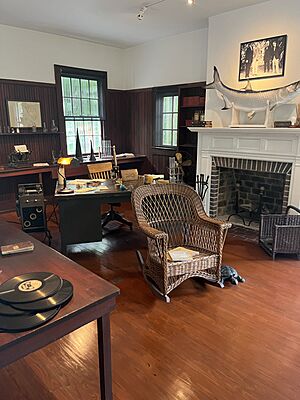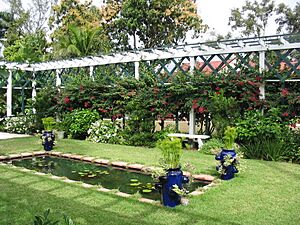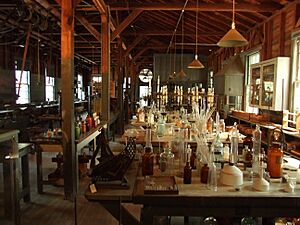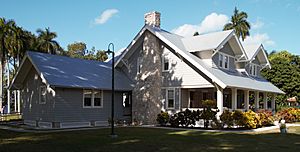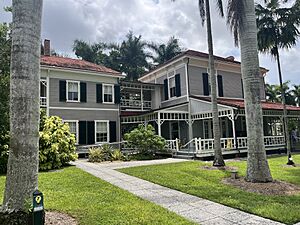Edison and Ford Winter Estates facts for kids
Quick facts for kids |
|
|
Thomas Edison Winter Estate and Henry Ford Estate
|
|

Seminole Lodge, the Edison family's winter home
|
|
| Location | Fort Myers, Florida |
|---|---|
| Built | 1886 (Edison Estate) 1911 (Ford Estate) |
| NRHP reference No. | 91001044 |
| Added to NRHP | September 8, 1988 (Ford Estate) August 12, 1991 (Edison Estate) |
The Edison and Ford Winter Estates are a cool historical museum and a big 21-acre (8.5 ha) botanical garden. They are located right next to each other. These estates were once the winter homes of two famous inventors: Thomas Edison and Henry Ford. You can find them by the Caloosahatchee River in Southwest Florida, at 2350 McGregor Boulevard, Fort Myers, Florida.
In 2012, the American Institute of Architects in Florida put the Edison and Ford Winter Estates on their special list called Florida Architecture: 100 Years. 100 Places. Also, in 2014, the American Chemical Society named Edison's Botanical Research Laboratory at the estates a National Historic Chemical Landmark. This was a big honor!
Contents
A Look Back: History of the Estates
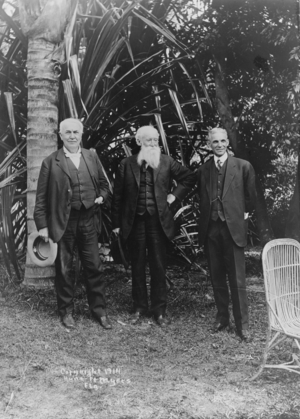
The story of these estates began in 1885. That's when Thomas Edison first visited Southwest Florida. He loved the area so much that he bought land to build a vacation home. Edison had been sick and his doctor suggested he go to a warmer place like St. Augustine, Florida. After feeling better there, he traveled to Fort Myers.
His home, finished in 1886, was called "Seminole Lodge." It was his winter getaway and a place to relax until he passed away in 1931.
Edison's good friend, Henry Ford, bought the land next door in 1916. Ford's house, "The Mangoes," was built in 1911. Years later, in 1947, Edison's wife, Mina Edison, gave the Edison property to the City of Fort Myers. She wanted the public to enjoy it in memory of her husband. It opened for tours soon after.
In 1988, Henry Ford's winter estate was also bought and opened for public tours in 1990. In 2003, a new non-profit group took over running the site. This group, now called Edison & Ford Winter Estates, Inc., works to protect and share the history of the estates. They completed a huge $14 million project to restore the site.
Exploring the Gardens
The botanical gardens here are amazing! They have over 1,750 plants from all over the world. You can see more than 890 different kinds of plants. This includes over 370 types of pretty ornamental plants. There are also 178 kinds of trees and 85 types of fruit trees.
You'll find 106 kinds of palms and 12 types of bamboo. There are also 23 kinds of cycads and 36 types of vines. Some cool plants include the African Sausage Tree. There's also a huge 400-foot (120 m) banyan tree that was planted in the 1920s.
Some plants were grown for industrial uses, like bamboo for light bulb filaments. Mina Edison also planted many beautiful flowers. These include roses, orchids, and bromeliads. The special Moonlight Garden was designed by Ellen Biddle Shipman.
Edison's Rubber Laboratory
During World War I (1914-1918), Thomas Edison worried about America needing rubber from other countries. He teamed up with Harvey Firestone and Henry Ford. They wanted to find a rubber plant that could grow fast in the United States. This would create a local supply of rubber.
In 1927, these three friends each gave $25,000 to start the Edison Botanic Research Corporation. Their goal was to solve the rubber problem. In 1928, the Edison Botanic Research Corporation laboratory was built. Edison did most of his research and planted many exotic plants and trees right here in Fort Myers.
Edison tested over 17,000 plant samples! He finally found a good source of rubber in a type of flowering goldenrod plant. It was called Solidago leavenworthii. Thomas Edison passed away in 1931. Five years later, the rubber project was given to the United States Department of Agriculture.
Visiting the Estates
When you visit the Edison and Ford Winter Estates in Fort Myers, you can explore over 20 acres of historic buildings and gardens. This includes the 1928 Botanical Laboratory and the Edison Ford Museum. There are also many fun programs, tours, and activities to enjoy.
The estates offer tours for schools and educational groups of all ages. They have a big summer camp program. There are also science and engineering classes for homeschool students. Younger children (18 months to 5 years) can join "emerging inventors" programs. Special events happen throughout the year. These include holiday nights, antique car shows, and garden talks. You can even reserve the site for events like weddings or group tours.
The Edison Ford Winter Estates is a National Register Historic Site. It has won awards for its restoration work. It is also a Florida Historic Landmark. The American Chemical Society named it a National Historical Chemical Landmark. It was the first place in Florida to get this special honor.
The research library at the Edison and Ford Winter Estates is also open by appointment. It has over a thousand books about Fort Myers history and plants. You can also find biographies about Thomas Edison, Henry Ford, and their families.
The estates have been open to the public since 1947. More than 200,000 people visit every year! It is a non-profit organization. It is managed by a board of trustees, staff, and many helpful volunteers.
Gallery
-
View of the Caloosahatchee River from the estate
See also
 In Spanish: Fincas de Invierno de Edison y Ford para niños
In Spanish: Fincas de Invierno de Edison y Ford para niños


